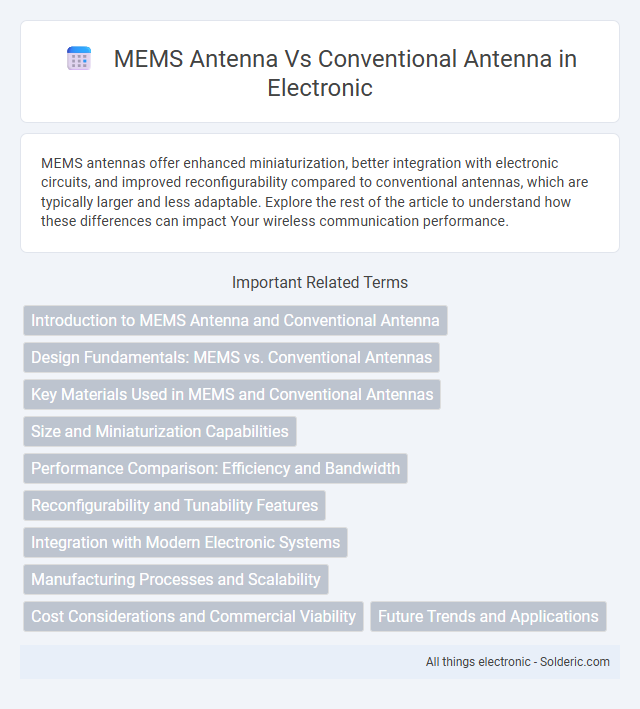MEMS antennas offer enhanced miniaturization, better integration with electronic circuits, and improved reconfigurability compared to conventional antennas, which are typically larger and less adaptable. Explore the rest of the article to understand how these differences can impact Your wireless communication performance.
Comparison Table
| Feature | MEMS Antenna | Conventional Antenna |
|---|---|---|
| Size | Miniaturized, compact | Larger, bulky |
| Tuning | Electrically tunable, dynamic | Fixed frequency or mechanically tuned |
| Integration | Easy integration with ICs | Separate component, complex integration |
| Power Consumption | Low power usage | Higher power requirements |
| Frequency Range | Wideband, reconfigurable | Narrowband, fixed range |
| Performance | High efficiency, less interference | Variable efficiency, susceptibility to interference |
| Cost | Higher initial cost, cost-effective at scale | Lower initial cost |
| Durability | Robust, resistant to mechanical stress | Fragile, sensitive to physical damage |
Introduction to MEMS Antenna and Conventional Antenna
MEMS antennas utilize micro-electromechanical systems technology to achieve miniaturization, enhanced tuning capabilities, and improved frequency agility compared to conventional antennas, which are typically larger and fixed in design. Conventional antennas rely on traditional materials like metal rods or patches, offering stable performance but limited flexibility in applications requiring adaptive frequency response. Your choice between MEMS and conventional antennas depends on factors such as size constraints, reconfigurability needs, and frequency bandwidth requirements.
Design Fundamentals: MEMS vs. Conventional Antennas
MEMS antennas integrate microelectromechanical systems technology allowing dynamic reconfiguration, miniaturization, and improved tuning capabilities, unlike conventional antennas which rely on fixed, rigid structures. The design fundamentals of MEMS antennas emphasize microscopic movable elements and silicon-based substrates to achieve enhanced performance and adaptability in compact spaces. Conventional antennas depend on static metallic elements and larger form factors, limiting flexibility and frequency agility compared to the versatile MEMS approach.
Key Materials Used in MEMS and Conventional Antennas
MEMS antennas primarily utilize materials such as silicon, gold, and piezoelectric substrates like quartz or lithium niobate, which enable miniaturization and enhanced tunability through micro-electromechanical structures. Conventional antennas commonly employ copper, aluminum, and brass due to their excellent electrical conductivity and ease of fabrication for larger-scale applications. The integration of MEMS-specific materials allows dynamic reconfiguration and improved performance in compact wireless devices, contrasting with the rigid and bulkier material composition of conventional antennas.
Size and Miniaturization Capabilities
MEMS antennas offer significantly enhanced size reduction and miniaturization capabilities compared to conventional antennas, enabling integration into compact wireless devices. Their microelectromechanical structures allow for precise tuning and reconfiguration at a microscale, which conventional antennas cannot achieve due to rigid physical dimensions. You benefit from improved spatial efficiency and design flexibility with MEMS antennas, making them ideal for modern, space-constrained applications.
Performance Comparison: Efficiency and Bandwidth
MEMS antennas exhibit superior efficiency and wider bandwidth compared to conventional antennas, thanks to their micro-electromechanical systems enabling precise tuning and reconfiguration capabilities. Their small size and tunable components reduce signal loss and enhance frequency agility, resulting in optimized performance across varying conditions. Your wireless devices benefit from improved signal clarity and more reliable connectivity when using MEMS antennas over traditional counterparts.
Reconfigurability and Tunability Features
MEMS antennas offer superior reconfigurability and tunability compared to conventional antennas through the integration of microelectromechanical systems, allowing dynamic adjustment of frequency, polarization, and radiation patterns. These features enable real-time adaptation to varying signal environments, improving communication performance and reducing interference. Conventional antennas lack this level of adaptability, often resulting in fixed operational parameters that limit flexibility in multifunctional applications.
Integration with Modern Electronic Systems
MEMS antennas offer superior integration with modern electronic systems due to their small size, low power consumption, and compatibility with semiconductor fabrication processes, enabling seamless embedding into compact devices. Conventional antennas typically require larger physical space and separate packaging, which can limit miniaturization and system-level integration. The MEMS technology facilitates enhanced performance in IoT, wearable devices, and advanced communication modules by providing tunability and reconfigurability directly on-chip.
Manufacturing Processes and Scalability
MEMS antennas leverage microelectromechanical systems technology, enabling precision fabrication through microfabrication techniques such as photolithography and etching, which support mass production with high repeatability. Conventional antennas are typically manufactured using bulkier processes like machining, stamping, or injection molding, which can limit miniaturization and scalability for complex designs. The scalability of MEMS antennas is enhanced by their compatibility with semiconductor manufacturing, allowing integration with other microelectronic components and cost-effective production at large volumes.
Cost Considerations and Commercial Viability
MEMS antennas offer cost advantages through miniaturization and integration, reducing material and manufacturing expenses compared to conventional antennas. Their ability to be mass-produced using semiconductor fabrication techniques enhances commercial viability, especially in compact, high-frequency applications such as IoT devices and mobile communications. Despite higher initial R&D costs, MEMS antennas often deliver lower total lifecycle costs and improved performance, making them attractive for large-scale deployment.
Future Trends and Applications
MEMS antennas, leveraging micro-electro-mechanical systems technology, offer enhanced miniaturization, reconfigurability, and improved performance compared to conventional antennas, driving future trends in wireless communication and IoT applications. Emerging fields such as 5G/6G networks, wearable devices, and adaptive radar systems increasingly rely on MEMS antennas' ability to dynamically adjust frequency and radiation patterns. Your next-generation communication systems will benefit from MEMS antennas' low power consumption, integration capabilities, and scalability in complex, multifunctional environments.
MEMS antenna vs conventional antenna Infographic

 solderic.com
solderic.com